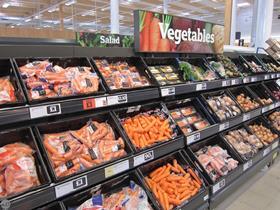
Sainsbury’s became the second major retailer to publish detailed figures on its food waste last week when it revealed the quantity of food waste converted to energy fell by 9.4 per cent.
This reduction in waste comes thanks to improvements in operational efficiency throughout the supply chain, according to the retailer, which followed Tesco’s example of publishing its food waste figures.
At Sainsbury’s total food waste to energy fell from 29,700 tonnes in 2014/15 to 26,910t in 2015/16, while Tesco revealed in June that it wasted 59,400t of food last year, a 4 per cent rise on the previous year.
Efficiency measures used by Sainsbury’s include greater collaboration with growers and farmers to ensure that what they grow matches as precisely as possible what is sold.
The supermarket is working to develop a model with one salad supplier to provide a precise crop schedule, which changes according to climate among other factors.
And, through a separate project, the retailer is closely monitoring the growth stages of potatoes in order to predict yield, plan availability better and reduce food waste.
The supermarket is also sourcing direct from some producers, particularly in citrus and salads, allowing it to get the product into store quicker and ensure it has a longer shelf-life.
Another measure that Sainsbury’s claims has helped reduce waste was its decision to phase out multi-deal buys in favour of EDLP in July 2016.
The benefits of this measure are twofold, according to the chain: firstly, it encourages customers to only purchase what they need and reduce waste in their homes; and secondly, it helps Sainsbury’s predict and manage its stock better to minimise wastage in its supply chain.
In addition to the reduction in food waste, the supermarket claims to dramatically expanded its food donation partnerships to over 1,000 in the past year.
In the last twelve months the number of Sainsbury’s stores that have at least one food donation partnership with a local charity increased by 145 per cent from 215 in 2014/15 to 833 in 2015/16.
But The Times questioned the extent of the retailer’s progress, pointing out that less than a tenth of Sainsbury’s donated produce was donated to charity.
A major exposé by The Evening Standard showed last week that only 7.6 per cent of the retailer’s waste is sent to charity. This is a higher percentage than for any other major retailer however. The second highest contributor was Tesco with just 4.5 per cent, while Aldi donated 0.5 per cent, Iceland donated none and Morrisons and Lidl did not disclose their figures on surplus food donations.



